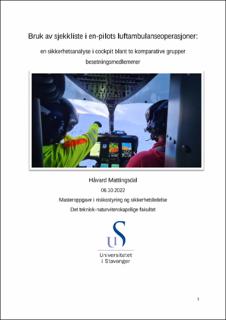| dc.contributor.advisor | Gould, Kenneth Arne Pettersen | |
| dc.contributor.author | Mattingsdal, Håvard | |
| dc.date.accessioned | 2023-01-11T16:51:32Z | |
| dc.date.available | 2023-01-11T16:51:32Z | |
| dc.date.issued | 2022 | |
| dc.identifier | no.uis:inspera:120095610:82020392 | |
| dc.identifier.uri | https://hdl.handle.net/11250/3042786 | |
| dc.description.abstract | Innledning: Luftambulansehelikopter driftes enten som et en-pilots (singel), eller et to-pilots system. I Norge er tjenesten en singel pilot operasjon med redningsmann og pilot i cockpit, som har et kompetanse- og sikkerhetsnivå tilnærmet likt et to-pilots system. Dette krever et kontinuerlig fokus på sikkerheten og redundansen ved akutt sykdom hos piloten, en såkalt inkapasitering. Et problem i dag er manglende nødprosedyrer ved slike hendelser. Løsningen kan være å innføre sjekklister tilpasset redningsmannen for en fullverdig håndtering av slike nødssituasjoner. Hensikten til denne studien er å analysere en simulert pilot inkapasitering og effekten av en nyutviklet sjekkliste, hvor redningsmannen utnytter helikopterets autopilotteknologi under alle flyforhold for en trygg håndtering og landing av helikopteret.
Metode: Eksperimentell studie i flysimulator under instrumentflygingsforhold med sammenligning av to komparative grupper redningsmenn. En kontrollgruppe (n=3) opererte etter dagens standard uten sjekkliste, sammenlignet med en intervensjonsgruppe (n=3) som benyttet ny sjekkliste. Sikkerhetsanalysen inkluderte menneskelige feilhandlinger med Systematic Human Error Reduction and Prediction Approach (SHERPA), objektiv arbeidsbelastning med Hjerte Rate Variabilitet (HRV) og subjektiv arbeidsbelastning med NASA Stress Load Index (TLX).
Resultat: Studien viste at redningsmennene som benyttet ny sjekkliste hadde signifikant færre registrerte menneskelige feilhandlinger (21 mot 80 hendelser, p<0,05), en ikke-signifikant forskjell i registrert objektiv arbeidsbelastning (12,1 mot 14,2 i stress index, p=0,4831) og signifikante forskjeller på subjektiv rapportert arbeidsbelastning (22,5 mot 57,5 i generell arbeidsbelastning, p<0,05), sammenlignet med gruppen som opererte etter dagens standard.
Konklusjon: Studien viser at en standardisert sjekkliste bidrar til økt sikkerhet ved singel pilot inkapasitering. Innføring av denne nye sjekklisten i luftambulansetjenesten er realistisk grunnet eksisterende kompetanse hos redningsmennene og tilgjengelig teknologi i cockpit. | |
| dc.description.abstract | Introduction: Helicopter Emergency Medical Services (HEMS) are operated either as a one-pilot (single) or a two-pilot system. In Norway, the service is a single pilot operation with a HEMS technical Crew Member (HCM) and a pilot in the cockpit, aiming for a level of competence and safety approximating to a two-pilot system. This carries a continuous focus on safety and redundancy in the event of an acute illness in the pilot, i.e. “pilot incapacitation”. Currently, the service lacks emergency procedures for such an incident. A solution could be to introduce checklists adapted to the HCM for such emergency situations. We aimed to analyse a simulated pilot incapacitation and the effect of a newly developed checklist, where the HCM utilizes the helicopter's autopilot technology for a safe handling and landing during all flight conditions.
Method: Experimental study in a flight simulator during Instrument Metrological Conditions (IMC) comparing two groups of HCMs. One control group (n=3) operated according to the current standard without a checklist, compared to an intervention group (n=3) which used the new checklist. The safety analysis included human error with the Systematic Human Error Reduction and Prediction Approach (SHERPA), objective workload with Heart Rate Variability (HRV) and subjective workload with the NASA Stress Load Index (TLX).
Results: The study showed that the HCMs who used the new checklist had significantly fewer recorded human errors (21 versus 80 incidents, p<0,05), smaller differences in recorded objective workload (12,1 versus 14,2 in the stress index, p=0,4831) and significant differences in subjectively reported workload (22,5 versus 57,5 in general workload, p<0,05), compared to the group that operated according to today's standard.
Conclusion: The study shows that a standardized checklist contributes to increased safety during pilot incapacitation in a single pilot with HCM operation. Introduction of this new checklist in Norwegian HEMS is realistic due to the existing competence of the HCMs and available technology in the cockpit. | |
| dc.language | nob | |
| dc.publisher | uis | |
| dc.title | Bruk av sjekkliste i en-pilots luftambulanseoperasjoner: en sikkerhetsanalyse i cockpit blant to komparative grupper besetningsmedlemmer | |
| dc.type | Master thesis | |
